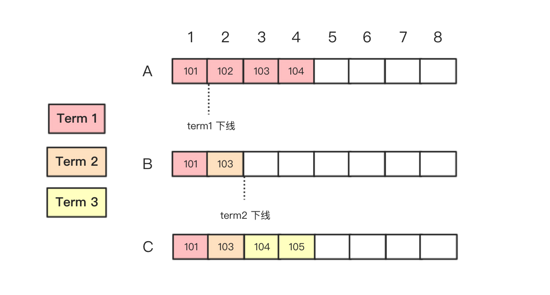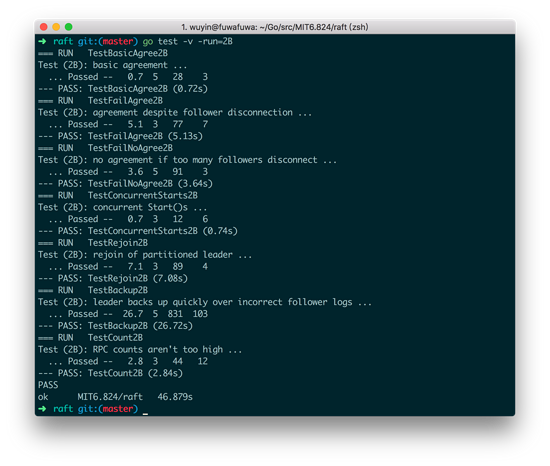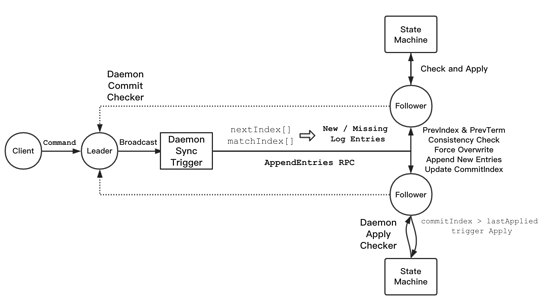总结下 MIT6.824 Lab2B Log Replication 的实验笔记。Lecture 参考: lab-raft.html
2A 部分完成了基础的 Leader Election 和 Heartbeat 机制,2B 部分要完成 Log Replication,同时实现论文中 5.4.1 节选举限制机制来保证选举的安全性。 本节实验目标是通过 test_test.go 中的 *2B 测试用例:

测试均通过:


Raft 的目标是在大多数节点都可用且能相互通信的前提下,保证多个节点上日志的一致性。日志的存储结构:
type LogEntry struct {
Term int
Command interface{}
}
Term 是 Raft 协议的逻辑时钟,用于检查日志的一致性。它有三种状态:
leader 通过 AppendEntries RPC 与各节点进行日志的同步。请求参数和响应参数如下:
type AppendEntriesArgs struct {
Term int // leader term
LeaderID int // so follower can redirect clients
PrevLogIndex int // index of log entry immediately preceding new ones
PrevLogTerm int // term of prevLogIndex entry
Entries []LogEntry // log entries to store (empty for heartbeat;may send more than one for efficiency)
LeaderCommit int // leader’s commitIndex
}
type AppendEntriesReply struct {
Term int // currentTerm, for leader to update itself
Succ bool // true if follower contained entry matching prevLogIndex and prevLogTerm
}
参考论文图 2,当节点收到此调用后,依次进行五个判断:
func (rf *Raft) AppendEntries(args *AppendEntriesArgs, reply *AppendEntriesReply) {
reply.Term = rf.curTerm
reply.Succ = false
if args.Term rf.curTerm {
rf.curTerm = args.Term
rf.back2Follower(args.Term, VOTE_NIL)
}
// now terms are same
rf.resetElectTimer()
// consistency check
last := len(rf.logs) - 1
if last last {
rf.logs = append(rf.logs, e) // new log, just append
committed = len(rf.logs) - 1
}
}
// if leaderCommit > commitIndex, set commitIndex =min(leaderCommit, index of last new entry)
if args.LeaderCommit > rf.commitIndex {
rf.commitIndex = min(committed, args.LeaderCommit) // need to commit
rf.applyCond.Broadcast() // trigger apply
}
rf.back2Follower(args.Term, args.LeaderID)
reply.Succ = true
}
// leader replicate logs or send heartneat to other nodes
func (rf *Raft) sync() {
for i := range rf.peers {
if i == rf.me {
rf.resetElectTimer()
continue
}
go func(server int) {
for {
if !rf.isLeader() {
return
}
rf.mu.Lock()
rf.syncConds[server].Wait() // wait for heartbeat or Start to trigger
// sync new log or missing logs to server
next := rf.nextIndex[server]
args := AppendEntriesArgs{
Term: rf.curTerm,
LeaderID: rf.me,
Entries: nil,
LeaderCommit: rf.commitIndex,
}
if next rf.curTerm { // higher term
rf.back2Follower(reply.Term, VOTE_NIL)
return
}
continue
}
// append succeed
rf.nextIndex[server] += len(args.Entries)
rf.matchIndex[server] = rf.nextIndex[server] - 1 // replicate succeed
}
}(i)
}
}
每个节点在 Make 初始化时会启动两个后台 goroutine:
lastApplied// apply (lastApplied, commitIndex] func (rf *Raft) waitApply() { for { rf.mu.Lock() rf.applyCond.Wait() // wait for new commit log trigger var logs []LogEntry // un apply logs applied := rf.lastApplied committed := rf.commitIndex if appliedCommit Checker
在设计实现时,leader 将日志的 replicate 和 commit 解耦,所以需要 leader 在后台循环检测本轮中哪些日志已被提交:
// leader daemon detect and commit log which has been replicated on majority successfully func (rf *Raft) leaderCommit() { for { if !rf.isLeader() { return } rf.mu.Lock() majority := len(rf.peers)/2 + 1 n := len(rf.logs) for i := n - 1; i > rf.commitIndex; i-- { // looking for newest commit index from tail to head // in current term, if replicated on majority, commit it replicated := 0 if rf.logs[i].Term == rf.curTerm { for server := range rf.peers { if rf.matchIndex[server] >= i { replicated += 1 } } } if replicated >= majority { // all (commitIndex, newest commitIndex] logs are committed // leader now apply them rf.applyCond.Broadcast() rf.commitIndex = i break } } rf.mu.Unlock() } }选举限制
参考论文 5.4.1 节,为保证选举安全,在投票环节限制:若 candidate 没有前任 leaders 已提交所有日志,就不能赢得选举。限制是通过比较 candidate 和 follower 的日志新旧实现的,Raft 对日志新旧的定义是,让两个节点比较各自的最后一条日志:
- 若任期号不同,任期号大的节点日志最新
- 若任期号相同,日志更长的节点日志最新
// election restrictions func (rf *Raft) RequestVote(args *RequestVoteArgs, reply *RequestVoteReply) { reply.Term = rf.curTerm reply.VoteGranted = false if args.Termrf.curTerm { rf.back2Follower(args.Term, VOTE_NIL) } // now the term are same // check up-to-date, from Paper: // if the logs have last entries with different terms, then the log with the later term is more up-to-date. // if the logs end with the same term, then whichever log is longer is more up-to-date. i := len(rf.logs) - 1 lastTerm := rf.logs[i].Term if lastTerm > args.LastLogTerm { return } if lastTerm == args.LastLogTerm && i > args.LastLogIndex { return } // now last index and term both matched if rf.votedFor == VOTE_NIL || rf.votedFor == args.CandidateID { reply.VoteGranted = true rf.back2Follower(args.Term, args.CandidateID) } return } 至此,梳理了 Lab2B 日志复制的设计流程、实现了选举限制 up-to-date。
总结
Lab2B 应该是三个部分最难的了,我前后折腾了两三个星期,从尝试到处飞的 channel 同步换到了 sync.Cond 才更易调试和实现。值得一提的是,文件结构上的解耦也是十分有必要的,比如我的:
➜ raft git:(master) tree . ├── config.go ├── persister.go ├── raft.go # 节点初始化,超时选举机制 ├── raft_entry.go # AppendEntries RPC 逻辑 ├── raft_leader.go # sync 日志,心跳通信等 ├── raft_peer.go # 定义超时时间 ├── raft_vote.go # RequestVote RPC 逻辑 ├── test_test.go └── util.go # 自定义的调试函数等为尊重课程的 Collaboration Policy,我把 GitHub repo 设为了 Private,由于经验有限,上述代码可能还有 bug,如您发现还望留言告知,感谢您的阅读。
以上就是本文的全部内容,希望对大家的学习有所帮助,也希望大家多多支持 我们

 京公网安备 11010802041100号 | 京ICP备19059560号-4 | PHP1.CN 第一PHP社区 版权所有
京公网安备 11010802041100号 | 京ICP备19059560号-4 | PHP1.CN 第一PHP社区 版权所有